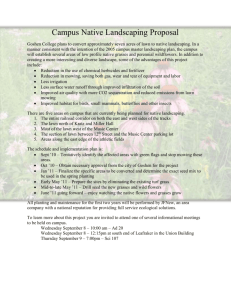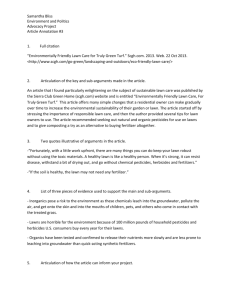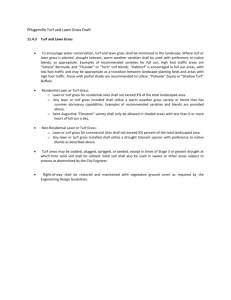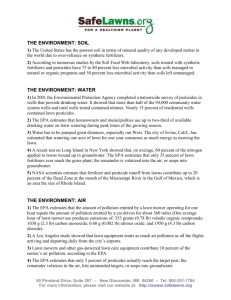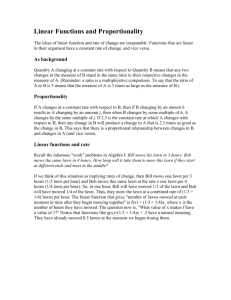Toulmin-Landscaping that Makes Sense for the West
advertisement
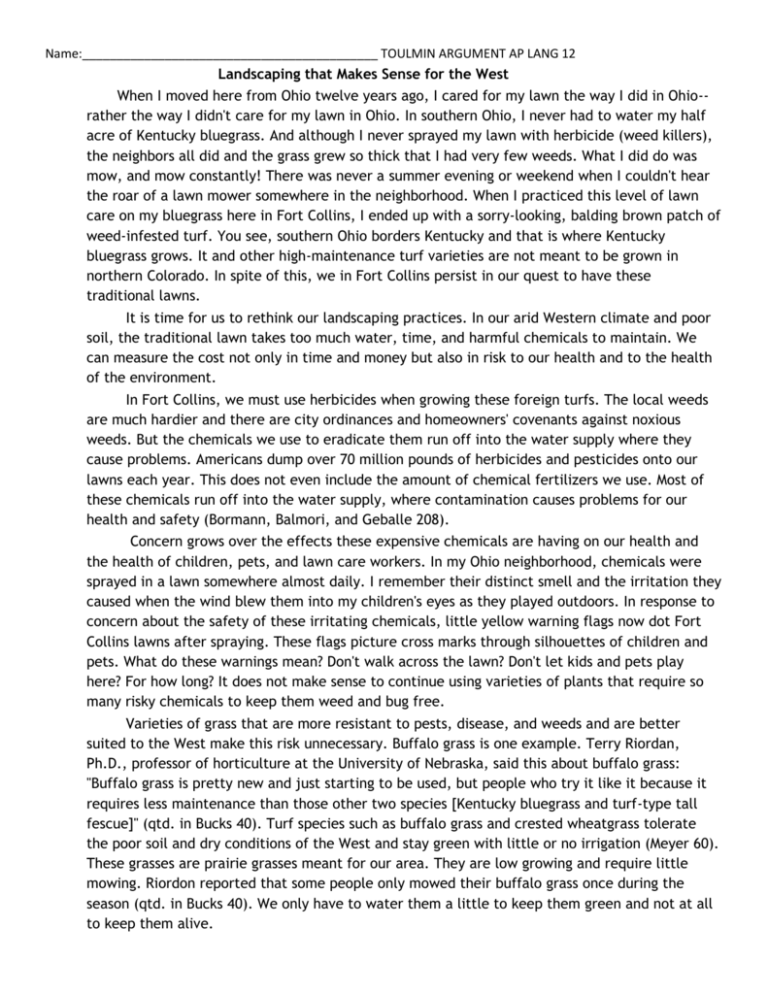
Name:___________________________________________ TOULMIN ARGUMENT AP LANG 12 Landscaping that Makes Sense for the West When I moved here from Ohio twelve years ago, I cared for my lawn the way I did in Ohio-rather the way I didn't care for my lawn in Ohio. In southern Ohio, I never had to water my half acre of Kentucky bluegrass. And although I never sprayed my lawn with herbicide (weed killers), the neighbors all did and the grass grew so thick that I had very few weeds. What I did do was mow, and mow constantly! There was never a summer evening or weekend when I couldn't hear the roar of a lawn mower somewhere in the neighborhood. When I practiced this level of lawn care on my bluegrass here in Fort Collins, I ended up with a sorry-looking, balding brown patch of weed-infested turf. You see, southern Ohio borders Kentucky and that is where Kentucky bluegrass grows. It and other high-maintenance turf varieties are not meant to be grown in northern Colorado. In spite of this, we in Fort Collins persist in our quest to have these traditional lawns. It is time for us to rethink our landscaping practices. In our arid Western climate and poor soil, the traditional lawn takes too much water, time, and harmful chemicals to maintain. We can measure the cost not only in time and money but also in risk to our health and to the health of the environment. In Fort Collins, we must use herbicides when growing these foreign turfs. The local weeds are much hardier and there are city ordinances and homeowners' covenants against noxious weeds. But the chemicals we use to eradicate them run off into the water supply where they cause problems. Americans dump over 70 million pounds of herbicides and pesticides onto our lawns each year. This does not even include the amount of chemical fertilizers we use. Most of these chemicals run off into the water supply, where contamination causes problems for our health and safety (Bormann, Balmori, and Geballe 208). Concern grows over the effects these expensive chemicals are having on our health and the health of children, pets, and lawn care workers. In my Ohio neighborhood, chemicals were sprayed in a lawn somewhere almost daily. I remember their distinct smell and the irritation they caused when the wind blew them into my children's eyes as they played outdoors. In response to concern about the safety of these irritating chemicals, little yellow warning flags now dot Fort Collins lawns after spraying. These flags picture cross marks through silhouettes of children and pets. What do these warnings mean? Don't walk across the lawn? Don't let kids and pets play here? For how long? It does not make sense to continue using varieties of plants that require so many risky chemicals to keep them weed and bug free. Varieties of grass that are more resistant to pests, disease, and weeds and are better suited to the West make this risk unnecessary. Buffalo grass is one example. Terry Riordan, Ph.D., professor of horticulture at the University of Nebraska, said this about buffalo grass: "Buffalo grass is pretty new and just starting to be used, but people who try it like it because it requires less maintenance than those other two species [Kentucky bluegrass and turf-type tall fescue]" (qtd. in Bucks 40). Turf species such as buffalo grass and crested wheatgrass tolerate the poor soil and dry conditions of the West and stay green with little or no irrigation (Meyer 60). These grasses are prairie grasses meant for our area. They are low growing and require little mowing. Riordon reported that some people only mowed their buffalo grass once during the season (qtd. in Bucks 40). We only have to water them a little to keep them green and not at all to keep them alive. Name:___________________________________________ TOULMIN ARGUMENT AP LANG 12 Choosing a variety that requires little or no watering also saves Fort Collins homeowners money. Water in the West is scarce and becoming more expensive. My summertime water usage increases by over 100 percent, from around 4,500 gallons per month to between 10,000 and 12,000 gallons per month. The average water use in Fort Collins rises by almost 150 percent to 14,500 gallons. Even with only one watering per week, 33 percent of my total yearly water usage is for my lawn. Most Fort Collins residents water more often, reflected in the higher average water usage of 55 to 58 percent. (See the chart on the following page.) In the West, 60 percent of urban water goes to watering lawns (Bormann, Balmori, and Geballe 107). In a telephone interview conducted March 24, 1997, Laura D'Audni of the Fort Collins City Water Utilities reported the yearly outdoor water use of Fort Collins residents is between 50 and 55 percent. If we choose turf varieties that require little or no watering, we could cut our water bills by this percentage. More appropriate species of grass would save time and money by making fertilizers and amendments obsolete. Our soil is not suited to bluegrass. It is poor, arid, and alkaline and must constantly be boosted with chemical fertilizers and amendments. Lawn care experts recommend that fertilizer be applied to bluegrass three to four times per growing season. They say we should aerate and thatch as well. I spend much more time and money to maintain a lawn in Fort Collins than I did in Ohio--and my lawn here is only one-third of my Ohio lawn. If I could afford it, I could hire this service done. There are companies who would come to my home four times a season to spray my lawn with "liquid fertilizer and weed control" for only $43.97 per application, plus $50.60 for yearly aeration. So let's add that up: the chemical pesticides and herbicides; the fertilizer; the water; the cost of a mower, gas, and its maintenance; and hoses which constantly sprout leaks, get chewed up by the dog, or run over by the mower (or factor in the more expensive irrigation system). Consider this: Basic Cost per Season for Care of Bluegrass Four chemical applications $175.88 Aeration $50.60 55-58 percent of yearly water bill $183.60 Mower maintenance and gas $35.00 Total $445.08 Name:___________________________________________ TOULMIN ARGUMENT AP LANG 12 Time Spent per Season in Basic Lawn Care Hours mowing and trimming (2 hours per week x 5 months) 43.3 hours Hours monitoring and moving hoses * (6 hours per week x 5 months) 129.6 hours Total 172.9 hours *This time could be cut down with multiple hoses going at the same time. I can think of plenty of other things I'd rather do with this money and time. I am probably not alone in thinking there has to be a better way. It is well past time that Coloradoans gave up their old-fashioned Eastern lawns for landscaping that makes sense in the West. So why aren't we hearing about alternatives from the lawn care industry? Because they have a lot to lose--billions of our dollars. Since the cost of maintaining an alternative is so low, lawn care experts have no stake in keeping us informed about more appropriate species or in making them easy to obtain. We get most of our information about lawn care and gardening from the lawn care industry itself. This is a conflict of interest. Most of the varieties of plants stocked in local nurseries require a lot of care and water to thrive. However, low-maintenance varieties are available and we can get the information we need to make good choices. We would do better to call our county extension office for information on species suitable to our area. In Fort Collins, an agent, referred to as a master gardener, can be reached at (970) 498-7400. They have been advocating alternative landscaping for some time. The most impartial information comes from sources that do not stand to gain monetarily from our choice. The Coloradoan's real estate section reprinted an article on landscaping from Popular Mechanics that stated, "Turf grasses are the foundation of every landscape plan, even when part of the plan is to reduce the percentage of grass in your yard. The only worthwhile suggestion here is to avoid traditional, short-root bluegrass varieties. These traditional turf grasses are notorious for their susceptibility to diseases and their reliance on huge quantities of water." It went on to describe a new variety of zoysia, Meyer Z-52, which was low maintenance, deep-rooted, less cold-sensitive, and stayed green longer (F1). If Fort Collins nurseries do not stock alternative types of seeds, they can be ordered and are comparable in price to other lawn seeds. (Buffalo grass is about $8 per pound.) To spare the expense of putting in a whole new lawn, these seeds can be used to overseed and to repair bare patches. In this way, they will gradually fill in and reseed themselves. Hardy trees, shrubs, groundcovers, and flowers that require almost no attention once they are established can be a beautiful alternative to turf, or a lovely compliment to smaller areas of an appropriate variety of turf. Flowers and shrubs that thrive in desertlike conditions and still produce beautiful foliage and blooms are available in local garden stores. The key is to plan, get good information, and choose plants appropriate to our region. A hardy groundcover Name:___________________________________________ TOULMIN ARGUMENT AP LANG 12 like Snow-on-the-Mountain will take over an area in a season or two and requires no maintenance to achieve a carpet of variegated green foliage. Flowers like cosmos and dianthus thrive on poor soil and dry conditions to produce their delicate and colorful blooms throughout the spring and summer growing season. There are many beautiful wildflower mixes that do well in the Rocky Mountain West. The cost of switching to less hungry and thirsty landscaping can quickly be made up in the cost saved on water and maintenance. Initial costs can be kept to a minimum by overseeding with these new types of grass seeds, seeding bare patches with them, and letting them take hold gradually. Lawn space can gradually be shrunk and given over to heat and drought-resistant varieties of flowers, trees, shrubs, and groundcovers. These new plants can be bought with the money saved from not having to buy chemicals and water. Choosing varieties that are perennial or that reseed themselves will also keep cost and maintenance to a minimum. With a little thought, planning, and creativity, we who live in Fort Collins can have beautiful landscapes that serve as restful retreats for ourselves and our families without the cost and the effort of trying to maintain an Eastern water-hungry lawn in the arid West. Works Cited Bormann, Herbert F., Diana Balmori, and Gordon T. Geballe. Redesigning the American Lawn. new Haven and London: Yale U P, 1993. Bucks, Christine. "The Right Grass = A Great Lawn." Organic Gardening May/Jun. 1995: 38-42. D'Audni, Laurie. Phone interview. 24 Mar. 1997. Meyer, Scott. "10 Common Lawn-Care Questions." Organic Gardening Feb. 1996: 58-61. Wasowski, Andy. "Cutting the Grass." Sierra Oct. 1996: 18-19. "Year-round Interest Important in Landscaping." Fort Collins Coloradoan 30 Mar. 1997: F1.
